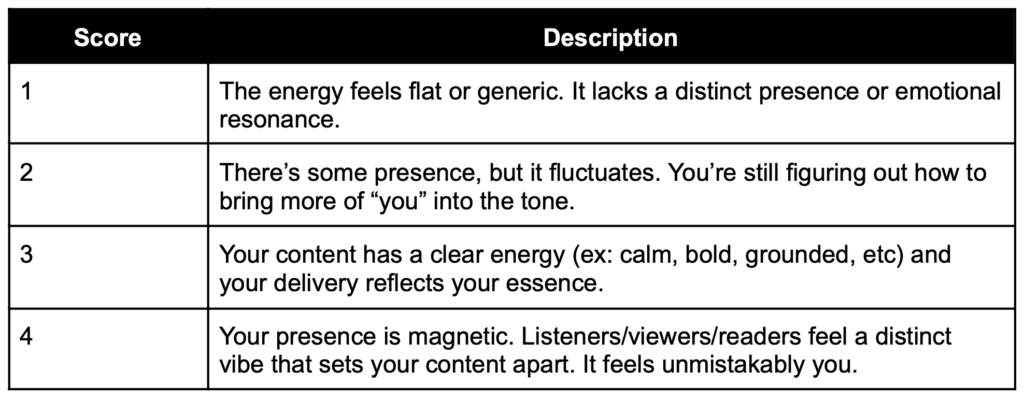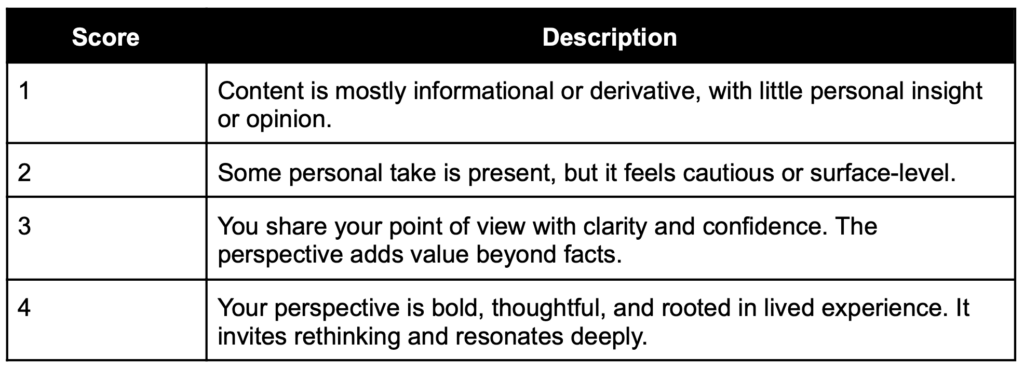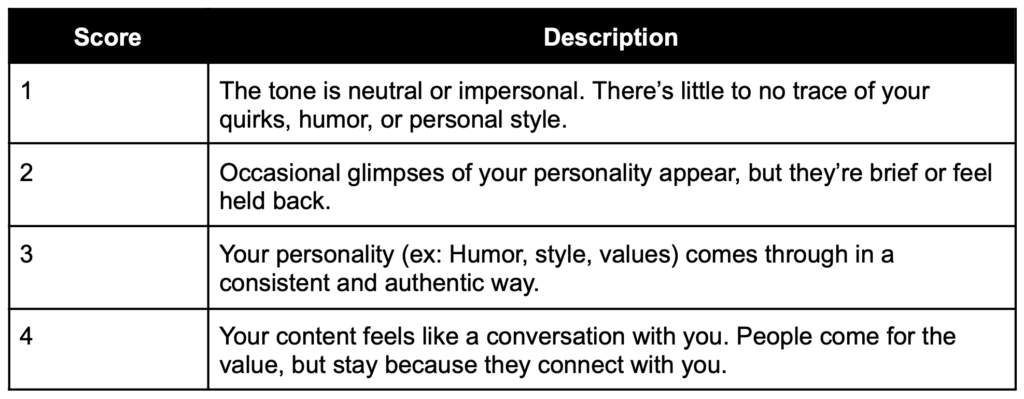[ANNOTATIONS 196] Substance takes time (but charisma can be practiced)
The edits and insights that got cut from episode 196 of EDIT HISTORY
🧠 Key Takeaway: Substance comes with time… But charisma and confidence can be practiced.
On episode 196 of EDIT HISTORY, Rae discusses how depth of presence comes from lived experience, but also shares actionable tools to practice charisma in the meantime.
✨ Cheryl commentary
One of my favorite moments from our conversation was when Rae and I talked about expressing enthusiasm and energy in your content, especially when sharing your work or offers.
Too often, creators simply say, “Here’s my new offer”… And that’s it.
But I’d argue: It’s your responsibility to present your work with the gravitas and energy that gets your audience into the right headspace, so they can truly appreciate the value of what you’re about to share.
How you introduce your ideas, offers, or content directly shapes how your audience perceives, receives, and responds to it.
Let me give you an example.
I’ve recently been obsessed with video clips of cat shows lol – Yes, the kind where judges evaluate cats based on breed standards. What fascinates me isn’t just the cats themselves…
It’s how the judges introduce each contestant.
Take the Persian cat. The judge doesn’t just say, “This is a Persian.” Instead, they introduce the cat with both authority and showmanship:
“This is a young male. Beautiful depth of color. The Persian is one of our most established breeds. What we’re looking for is a strong, big cat… Short body… Short tail… And everything else is nice and round. BIG, round, massive head. Tiny ears. Round paws. For shorter nose cats like the Persian, we need big nostrils… The grooming and presentation on this cat is absolutely stunning. Because at the end of the day, this is a beauty contest for cats.”
The enthusiasm! The specificity! The conviction!
Because the judge brings that cat to life for us, I find myself completely enthralled. I’ll watch the video all the way through and immediately want to see more. But if I had only seen a photo of the same cat, without that context or framing, I probably would’ve scrolled past.
And that’s the point.
As entrepreneurs and content creators, it’s our job to make the value of our work undeniably clear and exciting.
The way you present your ideas shapes how others interact with them. And your energy teaches your audience how to feel about your work.
So next time you launch, post, or pitch, don’t just “share the offer.” Introduce it like it deserves to be seen.
Bring your work to life with the same care and conviction you used to create it.
Here are 3 key takeaways that didn’t make it into the final episode:
🎙️ Cut 1: Rae’s “3 Ps” Framework for a Unique Voice – Presence, Perspective, and Personality.
Rae breaks down “unique voice” into a tangible, three-part framework:
- Presence – Your vibe, aura, or energy; the feeling you bring into a room before you say a word.
- Perspective – Your lived experiences and how you interpret the world; this is what sets your ideas apart in an age where knowledge is abundant but insight is rare.
- Personality – The relatable, human traits that people come to know over time; built through repeated interactions and intentional self-expression.
✨ Cheryl commentary
I created a rubric with a 1–4 scale for each of the “3 Ps” in Rae’s framework. Feel free to use this to assess how fully you are expressing each element in your content.
Presence: How does your energy, tone, and delivery land with your audience? Is your content infused with your emotional essence or leadership presence?

Perspective: Are you sharing a unique lens, belief, or experience, not just information? Is there original thought that distinguishes your voice?

Personality: How much of your relatable, human self comes through? Do people get a sense of who you are over time?

Total Score: __ / 12
- 3–5 → You’re still uncovering your unique voice. Your next step is to explore freely without judgment.
- 6–8 → You’re developing consistency. Now is the time to experiment with turning the dial up on under-expressed areas.
- 9–10 → Your voice is strong. Let’s refine it to build resonance and recognition.
- 11–12 → You’re embodying a distinctive, multidimensional voice. Double down and keep evolving.
🎙️ Cut 2: Balancing inspiration with strategy
Rae describes two internal states every creator must learn to manage:
- The inspired, intuitive self who writes from flow and excitement
- The strategic self (i.e. her “boardroom”) who assesses whether content is aligned with her audience and goals
Rather than rejecting one or the other, Rae brings them into conversation. She lets inspiration lead, then filters ideas through her boardroom. Rae then refines wording, tone, and messaging to ensure the right people hear what they need to hear.
✨ Cheryl commentary
To take this further, I want to paint a vivid, nuanced picture of the four different states a creator might find themselves in when it comes to balancing inspiration and strategy. These distinctions can help you reflect on how they’re currently approaching content, and what might need adjusting.
When You Have Inspiration but Not Strategy
What it feels like:
- Ideas pour in at random times
- You feel excited to share, and the words often flow
- You post from emotion or enthusiasm, often on impulse
What might happen:
- You produce a lot of content… But wonder why it’s not leading to clients or clear outcomes
- Your message might feel scattered or hard to follow
- You may attract attention, but not necessarily action (ex: Likes but no sales)
Cheryl’s tip: Before you publish, ask: What is this a “case study” of?
Inspired content often reflects a lived moment, but without strategy, it floats untethered. Ask yourself: If someone studied this post, what would they learn about my values, my work, or my people/clients?
When You Have Strategy but No Inspiration
What it feels like:
- You know what “should” be said… But you feel so ughhhh about saying it
- You’re stuck in outlines, frameworks, or marketing formulas
- Content becomes a checklist item, not a creative act
What might happen:
- Posts may be technically sound but emotionally flat
- You feel robotic or detached from your message
- Audience engagement drops because something is “off” energetically
Cheryl’s tip: Write a post that your past self needed, but your present self is slightly embarrassed to publish.
This tension between usefulness and vulnerability is where powerful content lives. Strategy alone can make your content too polished. Tap into something slightly uncomfortable to re-ignite your voice and re-humanize your message.
When You Have Neither Inspiration Nor Strategy
What it feels like:
- Everything feels dry. You don’t know what to say
- You scroll, overthink, compare. You avoid posting altogether
- The idea of “showing up” creates more pressure than joy
What might happen:
- You go silent or inconsistent
- You lose confidence in your voice or worry you’re “falling behind”
- You question if any of it matters
Cheryl’s tip: Instead of writing with an audience in mind, write down what you’d be willing to say aloud to a close friend.
Sometimes, the first step out of this fog isn’t to create for an audience, but it’s to reconnect with your inner clarity. Strip away the performance. If you had no pressure to sound smart or helpful, what would you say in a WhatsApp voice note to someone who gets it?
When You Have Both Inspiration and Strategy
What it feels like:
- You’re in a creative groove and your message is crystal clear
- Your content feels aligned and high-impact
- You speak with both resonance and structure
What might happen:
- You attract ideal clients, collaborators, and aligned opportunities
- You start to build a recognizable voice and body of work
- Creation feels energizing and sustainable
Cheryl’s tip: Batch your voice, not your content.
When you’re in flow, create reference points. Capture your tone, phrases, metaphors, and stories that feel most “you.” These become anchor materials for future content seasons where inspiration dips. Think of this like creating an archive or museum of your voice.
🎙️ Cut 3: Content misalignment is a symptom of something deeper
When Rae feels misaligned in life or business, her content creation slows down. Not because she’s lazy or lacks ideas, but because inspiration is deeply tied to alignment. She once went six months barely creating. That silence told her something had to shift.
Rather than push through or manufacture content, Rae treats the lack of inspiration as a message – Or even an invitation to recalibrate. That honesty is a big part of what’s kept her business and creativity sustainable over the years.
✨ Cheryl commentary
When Rae talked about content misalignment, this got me thinking about energy rhythms.
Every human has their own unique peak performance windows. Some of us are early risers, with sharp thinking before 10am. Others don’t hit their creative stride until dusk.
When do you feel most energized, focused, or idea-rich, and when do you feel foggy, resistant, or reactive?
These patterns are data.
But here’s the thing: It’s hard to read your own rhythm when you’re dysregulated.
I’ve met creators who are running on five hours of sleep or skipping meals, and their body cannot show its optimal timing. If anything, it’s just trying to survive.
Likewise, if your thoughts are clouded by self-doubt, comparison, or shame, even your most creative impulses can feel inaccessible.
That’s why I personally believe that “misalignment” isn’t just about what you’re posting, but it’s also about your internal state when you’re trying to create.
Misalignment often reflects back the state of your body, your beliefs, and your unmet needs.
Instead of forcing output, I’ve found it far more helpful to look at:
- What is my body trying to tell me?
- What part of me feels exhausted, anxious, dejected, etc right now?
- What kind of support – physical, emotional, creative – might I need before I return to typing on my keyboard?
You don’t need to wait for “alignment” to arrive perfectly. But you can create the conditions that invite it back.
Sounds good? Awesome. Let’s get to work.
SOUNDS GOOD? AWESOME. LET'S GET TO WORK
Copyright © 2025 Cheryl Lau Coaching and Consulting All Rights Reserved | Privacy Policy · Terms of Use · Brand & Website Design by Studio Naghisa